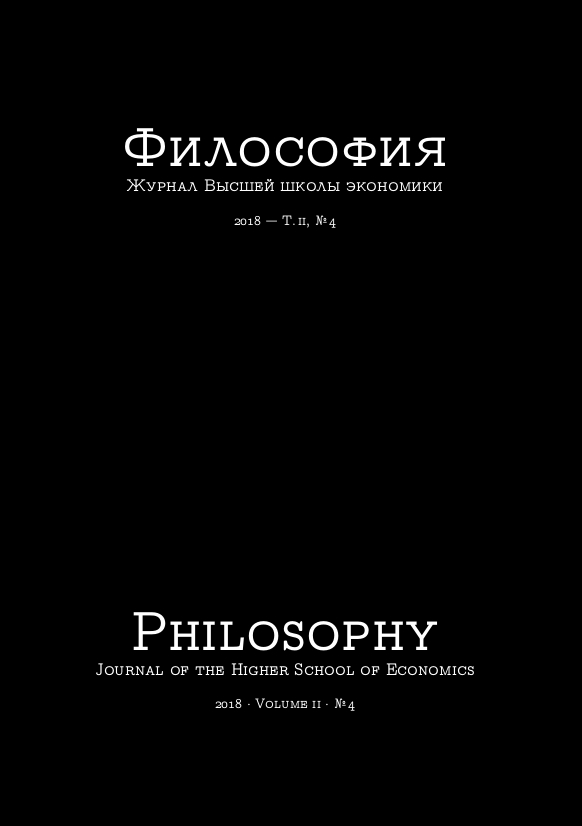Consciousness and Symbol
Abstract
The issue brought to your attention is not typical. It stands out from the familiar landscape of contemporary philosophical discussions, where oases of genuine thoughts are situated in the midst of deserts of meaningless reviews, and the flowering valleys of respectable schools are separated by the mountain ranges of conceptual and methodological incommensurability. The authors of this issue speak different philosophical languages and use different conceptual optics. However, what unites them is that they are trying to return personal depth to philosophical questioning and dare to re-ask questions that seem to have ready answers.
The main theme of the issue clearly refers to the book by Merab Mamardashvili and Alexander Pyatigorsky Symbol and Consciousness: Metaphysical Arguments about Consciousness, Symbolism and Language. What can be said about the consciousness and symbol from the standpoints of modern phenomenology, analytic philosophy, transcendentalism, and metaphysical realism? From what evidence do they emanate, what intuitions underlie their traditions? Where are those borders, on the approaches to which our intuitions fall silent, and the evidence is misleading?
In Viktoriya Faybyshenko’s paper, the motive of “birth” as a constitutive human ability, a free phenomenon, the cause of itself (according to Mamardashvili’s phenomenological project) is investigated at length. In response to the problem of combining the fundamental tautology of the act of consciousness and the need for an individual, irreplaceable event of human thought, the paper provides an original interpretation of the transcendental act, occurring in “unpredictable concreteness here-and-now” and giving a place for “birth itself” to be born.
Whereas for Mamardashvili, an event of thought is a realization of a symbol, and at the same time a kind of “empty” transcendental symbol, for Kantor and Florensky, as Tatyana Levina shows in her paper, the symbol turns out to be something greater. Comparing the metaphysical and epistemological aspects of this concept (the most important link in both cases is the idea of infinity), she shows the existence of unexpected interrelations between analytic philosophy and Russian religious thought of the late 19th – early 20thcenturies, as well as the deep immersion of both currents in the general context of European philosophy, as it developed from Augustine and Nicholas of Cusa to Kant and Leibniz.
A peculiar counterpoint to the topic of birth is the phenomenology of death, analyzed by Ilya Pavlov in his paper. The author shows the transformation of Heideggerian death phenomenology within the works of Vladimir Bibikhin. Such a transformation has become possible due to the use of a different ontology of time. For Bibikhin, death is phenomenologically close to the amechania, the restriction of human initiative.
But is the experience of birth and death available only to a human being, are humans the only species familiar with the event of thinking? Starting from Mamardashvili’s Cartesian Meditations, Yulia Gorbatova offers a very sincere essay for a panel discussion. Her essay is devoted, it would seem, to the naive question of whether animals are capable of thinking – but the deeper we look at this “simple” question, the more complex it seems. By problematizing the methodological guidelines of “mental anthropocentrism” on the one hand, and “radical anti-speciesism” on the other, she tries to eliminate false analogies and irrelevant meanings from the discussion in order to return to the heart of the matter. To do this, she has to combine metaphysical constructions with the transcendentalistic reasoning about the boundaries of language and the world. The discussion participants – Aleksey Gaginskiy, Igor Gasparov, Sergei Zhdanov, Konstantin Pavlov-Pinus, Diana Gasparyan, Sofiya Danko – mainly offer their own configurations of basic concepts and come to different answers to the questions asked. At the same time, all the authors of this block appear to be on the same philosophical wavelength, which makes their dialogue intense and fascinating.
In the “Archive of Philosophical Thought” section, you will find a translation of the famous Ullin Place’s paper “Is Consciousness a Brain Process?” made by Mariya Sekatskaya. The accompanying analytical article “The Philosophy of Ulin Place: From Mysticism to Materialism” by Mariya Sekatskaya and Anton Kuznetsov makes it possible to understand the general context of this work and its influence on the philosophy of mind in the second half of the 20th century.
In the “Book Reviews”, “In the Margins of Philosophical Treatises” and “Academical Life” sections you can find philosophical reviews, reflections on book novelties and reports on important philosophical conferences of the year.






